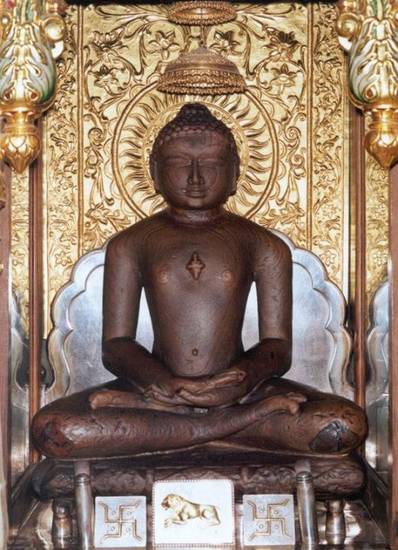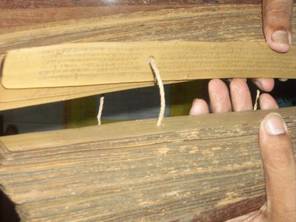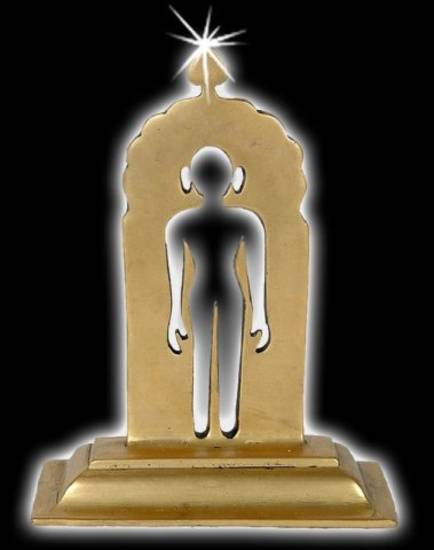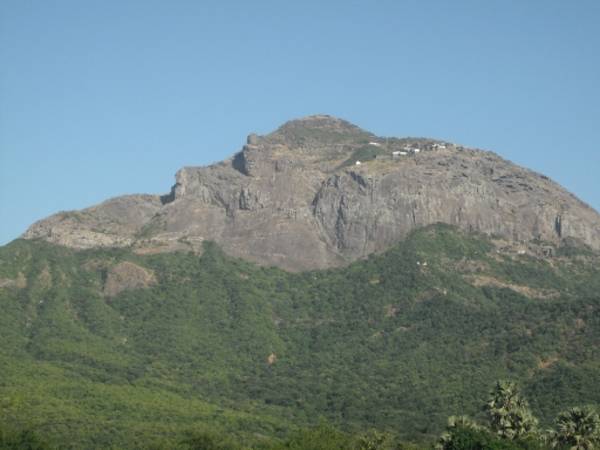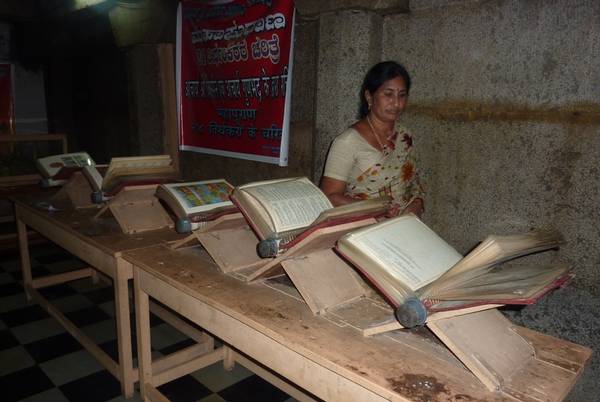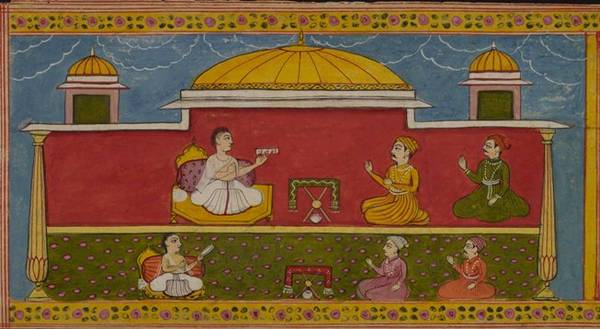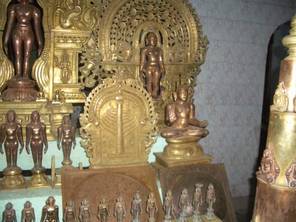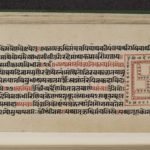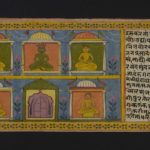Article: Digambara canon
As with most religious traditions, Jainism has scriptures that contain its fundamental principles and provides guidance and examples to believers. All Jains believe that their teachings come originally from the Jinas, who each reveals the same eternal truths according to the needs of his era of time. The most recent Jina, Mahāvīra, has given the fullest set of principles and guidance. All Jain sects agree that this teaching was originally passed on orally, but over the centuries elements were lost while other parts changed. They concur that after several centuries Mahāvīra’s teachings were written down, creating the sacred writings. The sects do not agree, however, on which portions of the teachings survived and which were amended. For this reason the Digambara and Śvetāmbara Jains have different sets of scripture.
Digambaras maintain that all the original scriptures were lost as early as the 2nd century CE. Thus they do not accept as authentic the works that make up the Śvetāmbara canon, although they list them occasionally. Instead, two other early texts form the basis of the Digambara canon or Siddhānta – ‘doctrine’. Their canon also includes later works covering various fields of knowledge, known as the Anuyogas – ‘expositions’.
Scholars have not examined these vast works in as much detail as the Śvetāmbara Āgamas. This is in large part because they have not been widely available for scholarly purposes until recently. They were first published in 1939, after longstanding opposition. In addition, they are highly technical and were probably understood only by advanced scholar monks. Also, Digambara manuscripts were generally written on palm leaves from south India and are thus more fragile than paper manuscripts from northern or western India. Surviving palm-leaf manuscripts are very rare.
Jains must master knowledge of various kinds to progress spiritually towards omniscience and eventual liberation from the cycle of rebirth. Jain epistemology names the second kind of knowledge as śruta-jñāna – ‘knowledge of what has been heard’. This usually means understanding of the scriptures. Even so, there is disagreement over whether scriptural knowledge by itself is sufficient for spiritual development.
All Jains know about their sacred texts, even if they do not have direct access to the scriptures. The holy writings are fundamental to religious ceremonies and practices, and to religious life more broadly. Jains venerate scriptures in various ways, the most prominent example of which is the festival of Śruta-pañcamī among Digambaras. Holy books are central to this annual celebration of knowledge. The respect with which Digambara Jains honour the scriptures is most remarkable in the subsect of Tāraṇ Svāmī Panth, which reveres books instead of idols of the Jinas or other figures.
Terms
Labelling the Jain sacred texts the ‘canon’ is often considered unsatisfactory, because the term generally describes an unchanging body of texts endorsed by a supreme authority. Digambara Jains usually call their holy writings siddhānta – ‘doctrine’ in Sanskrit. A pan-Indian term, this word implies validity and authority.
Digambaras also use the terms niggantha-pāvayaṇa – ‘open teaching of monks’ – or orgaṇi-piḍaga – ‘basket of the chief disciples’. These Prakrit phrases are used in the singular and suggest that the primary sources are relevant to all.
The term siddhānta implies a flexible, changing group of texts. The two principal scriptures preserve elements of the Pūrvas written by Mahāvīra’s closest followers – gaṇadharas – while later texts composed by mendicants make up a second group of the scriptures. While the first group is therefore stable, this second group is quite fluid.
History of Digambara holy writings
Jains of all sects agree that the ultimate source of the teachings is the Jinas, especially Mahāvīra, the 24th. The Jinas preach unchanging truths to their followers, who pass on their knowledge orally to successive leaders, known as elders and teachers. Down the generations, some of these teachings were gradually lost and other parts altered. All Jains believe that surviving teachings were eventually written down, producing the holy texts.
Both major sects agree that large elements of the teachings had been forgotten by the 4th century BCE, such as the Pūrvas and the 12th Aṅga, the Dṛṣṭi-vāda. The origins of the differences between the Digambara and Śvetāmbara canons can be found in the physical division of the Jain community around 300 BCE. The group of Jains who can be thought of as forerunners of the Digambara sect travelled south to escape a long famine in the north, where Jainism had its stronghold. The Jains who remained in the north organised official recitations – vācanās – or ‘councils’ to consolidate knowledge of the teachings, which were at greater risk of being lost in this time of crisis. Successive councils produced what is now considered to be the Śvetāmbara canon, with the last council held at Valabhī, Gujarat in the 5th century CE. The Jains who later developed into the Digambara sect did not accept any of these councils and therefore none of their redactions. They believe that fragments of the Pūrvas, which were all that the oral tradition had preserved, were written down only in the 2nd century CE. These two scriptures form the crux of the Digambara canon or siddhānta.
Dates of the texts
It is hard to assign dates to Digambara scriptures with absolute confidence. This is mainly because of the very long gaps between various stages of the transmission process. The period when oral transmission was the principal method of passing on teachings is accepted to begin roughly with the life of the 24th Jina Mahāvīra. It ends with the first known writing down of oral works. Scholars have established Mahāvīra’s historical dates as 497 to 425 BCE. Digambara scriptures were first written down in the second century CE, some six hundred years after their oral origins.
In addition, there is an interval between this traditional writing down and the date of the earliest manuscripts. Another consideration is what has lasted. Digambara texts were normally written on palm leaves, which have not survived in large numbers. The oldest examples of palm-leaf manuscripts date back to the 11th to 12th centuries while the first two scriptures were composed nearly a thousand years earlier. The later Anuyogas have dates ranging from the 2nd and the 11th centuries so some are nearly as old.
Despite these problems, scholars can calculate the scriptures’ likely dates by using internal characteristics of the texts and surviving manuscripts. Comparing features such as language, vocabulary, literary styles and material characteristics in many examples of the same text, researchers can work out approximate dates.
The Digambara scriptures are probably of ‘a date contemporary with later Śvetāmbara canonical texts’ (Dundas 2002: 80), and early verse commentaries thereupon. This is demonstrated by similarities in their contents and formal criteria, such as the type of metre used in verse. This dates them to the 5th century at the latest.
Siddhānta
The Digambara canon or siddhānta comprises numerous texts. Two are believed to be all that remains of the original Pūrvas and were composed in the 2nd to 3rd century. The rest of the canon is made up of later texts, called the Anuyogas or ‘Expositions’, which are categorised into four classes. The Anuyoga texts may be grouped in different ways, sometimes presented in one class, sometimes in another according to the criteria used, so their number and positions are not universally agreed.
The two oldest scriptures are the holiest because they contain elements of the Pūrvas created by Mahāvīra’s chief disciples that captured and shaped his teachings. Both the Ṣaṭkhaṇḍāgama – Scripture in Six Parts – and the Kaṣāya-prābhṛta – Treatise on Passions – are highly technical works on karma. Though written in the 9th century, chiefly by Vīrasena, the commentaries are usually read alongside them, since they are hard to understand otherwise.
Since there is no agreement on the texts that comprise the Anuyoga group of scriptures, the number of texts is fluid. The Anuyogas were written between the 2nd and the 11th centuries CE, either in Jaina Śaurasenī Prakrit or in Sanskrit. They explore various key fields of knowledge and conduct, such as the behaviour of mendicants and laity, cosmology, the soul and philosophy.
On the whole, Digambara scriptures have received less attention from scholars in the West than their Śvetāmbara counterparts. This is principally because of the higher number of Śvetāmbara manuscripts in the West, a result of earlier and more frequent historical encounters between Europeans and Śvetāmbara Jains. Digambaras have also resisted attempts to make their holy works widely available for research until relatively recently. For these reasons, statements about the Digambara canon can be made with less certainty than similar ones about Śvetāmbara scriptures.
Like the Śvetāmbara sacred writings, Digambara scriptures are written in Prakrit and have been the focus of commentaries almost since their composition.
Ṣaṭkhaṇḍāgama – Scripture in Six Parts
The oldest Digambara text is supposedly based on one of the Pūrvas, a small part of which had been remembered by the monk Dharasena, who lived in the 2nd century CE. Tradition has it that he passed it on to his disciples after calling them to his retreat on Mount Girnar, in the ‘Moon Cave’. Puṣpadanta and Bhūtabali committed the teachings to writing. Thus it could be that this work is actually the first written text of the Jains. This explains why Puṣpadanta and Bhūtabali are venerated during the Digambara festival of knowledge, the Śruta-pañcamī.
The Scripture in Six Parts is an extensive treatise on Karmakarma theory, which includes calculations and subdivisions. Dealing with karma and its attachment to the soul, and with the nature of karma, it is written in concise prose, mostly in the aphoristic style. It is highly technical and widely accepted as meant only for specialists. It involves a lot of methodology and scholastics akin to what the Śvetāmbara tradition has preserved in the Cūlikā texts, such as the Nandī-sūtra or in the Anuyogadvāra-sūtra.
As its name suggests, the Ṣaṭkhaṇḍāgama is in six parts.
|
Number |
Title |
English meaning |
Aphorisms |
|---|---|---|---|
|
1 |
Jīva-sthāna |
‘states of the living’ |
2375 |
|
2 |
‘karmic bondage’ |
1585 |
|
|
3 |
Bandha-svāmitva-vicaya |
‘thoughts on karmic bondage by living beings’ |
324 |
|
4 |
Vedanā |
‘experiencing the karmas’ |
1449 |
|
5 |
Vargaṇā |
‘structurally similar groupings’ |
1027 |
|
6 |
Mahā-bandha |
‘great karmic bond’ |
40,000 granthas |
This table is based on Nand Lal Jain 2004: xiv to xv and Divakar 2000, I: 16ff.
The last part, ‘Mahā-bandha’, is also called ‘Mahā-dhavalā’ – ‘Great Luminous’. It has been transmitted separately, probably because:
- it is much larger than all the other parts put together
- Vīrasena has not commented upon it (Jain in Diwakar 2000, I: 14).
The eminent scholar monk Vīrasena completed his commentary on the first five parts in 816 CE. Written in both Prakrit and Sanskrit, this commentary is known as Dhavalā – Luminous.
Kaṣāya-prābhṛta – Treatise on Passions
Compiled by the monk Guṇabhadra in the 2nd to 3rd century CE, the second Digambara scripture is also based on the Pūrvas. It deals with the passions – kaṣāyas – or attachments to things of the world. These passions are the result of the deluding karma – mohanīya-karma.
The Kaṣāya-prābhṛta is written in 180 verses. It is short and rich. It has to be read with the Jaya-dhavalā – Victoriously Luminous. Vīrasena began writing this extensive commentary in Prakrit and Sanskrit but it was completed by Jinasena in 820 CE.
Other scriptures
The Digambara scriptural tradition is extremely rich and interesting. As well as the two main scriptures, the Digambaras include several other reference works in their canon, which are known as the Anuyogas or ‘Expositions’. These were composed between the 2nd and the 11th centuries CE, either in Jaina Śaurasenī Prakrit or in Sanskrit. They are grouped in four categories, representing various fields of knowledge and learning.
|
Title |
English meaning |
Detail |
Texts |
|---|---|---|---|
|
Prathamānuyoga |
‘First Exposition’ |
Jain epics presenting Digambara versions of: |
|
|
|
|
for example the 7th-century Padma-purāṇa by Raviṣeṇa |
|
|
|
|
for example Jinasena’s Harivaṃśa-purāṇa, from the 8th century |
|
|
|
|
|
comprising:
|
|
Karaṇānuyoga |
‘Exposition on Calculations and Techniques’ |
Treatises on technical matters: |
|
|
|
|
for example:
|
|
|
|
|
for example, Nemicandra-Siddhānta-cakravartin’s Gommaṭa-sāra |
|
|
Caraṇānuyoga |
‘Exposition on Conduct’ |
Treatises on: |
|
|
|
|
for example:
|
|
|
|
|
|
the 5th-century Ratnakaraṇḍaka-Śrāvakācāra by Samantabhadra is one of the earliest works on this topic |
|
|
|
|
Kundakunda’s works from the 2nd to 3rd centuries, such as the famous Samaya-sāra, deal as much with monastic accomplishment as with inner development and purity of the soul. They are the starting point of the Digambara mystic tradition and inspired several Jain thinkers, from Yogīndu to Rājacandra. |
|
Dravyānuyoga |
‘Exposition on Substances’ |
Treatises on: |
|
|
|
|
|
Umāsvāmin’s comprehensive Tattvārtha-sūtra is the standard work |
|
|
|
|
various philosophical works by:
|
This table of topics and texts should be viewed as presenting a sample of authoritative works, in no way giving an exhaustive list. Certain texts may appear in different anuyogas, according to the classification system used.
Language
The holy texts of both the Digambara and Śvetāmbara sects are written in the Prakrit language. In Mahāvīra’s time Sanskrit was used for the sacred texts of the brahmins and was the language of the elite. It is likely that Sanskrit was not used to write down the Jain teachings so that they were as widely accessible as possible. Since Mahāvīra’s teaching was ‘open’ to all – suggested by the term pavayaṇa – it was written in the most commonly used language.
The Digambara siddhānta is written in Jaina Śaurasenī Prakrit. Its chief differences from other forms of Prakrit are to do with phonetics so somebody who understands one Prakrit can also understand other forms. Digambaras also used a later form of Prakrit known as Apabhraṃśa, which is the language of some poetical treatises and narratives.
Since the 14th century, regional languages became more widely used in teaching and commenting on scriptural texts. Prakrit and Sanskrit remained in use, however, with different languages chosen according to the context and education levels of the expected audience. Digambaras in north India tended to employ Hindi and Rajasthani, found in the commentaries called vācanikās. Those in the south used Kannara or Tamil. These may be lengthy, detailed explanations or word-to-word paraphrases, more or less translations.
Studying and teaching the siddhānta
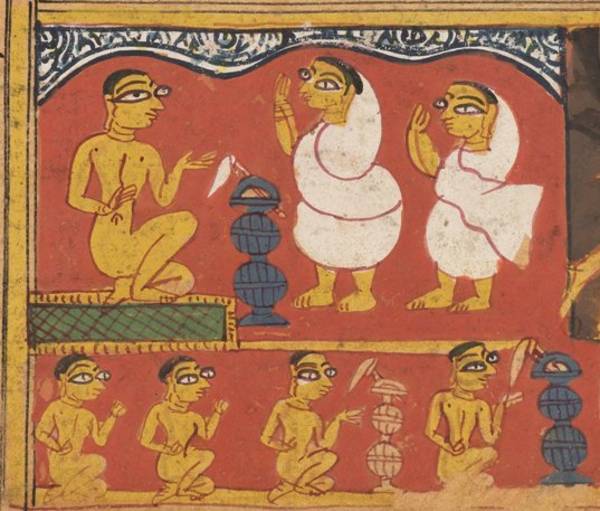
Monks and novices
Image by Wellcome Trust Library © Wellcome Library, London
A range of attitudes towards ways of using the holy texts can be found among Digambara Jains. Through the centuries scholar monks have referenced the scriptures to give authority to their opinions in intellectual arguments. Despite the crucial role of scriptural knowledge in spiritual progress, many Jains have not had direct access to the holy writings. Attitudes to reading the scriptures differ among the various Digambara sects and may depend on whether the reader is lay or mendicant. The idea of publishing the scriptures has also been hotly contested.
Proof of scriptural knowledge being used to support arguments is plentiful since the medieval period. The sectarian divisions common among Digambaras from at least the fifth century were often fuelled by different interpretations of various holy texts. Scholar monks tended to quote phrases and whole sections of certain works. One popular method of promoting viewpoints included scriptural quotations in the format of a dialogue of questions and answers. These texts – praśnottaras or bols – remain favoured pedagogical tools.
The Digambara subsects demonstrate a variety of attitudes towards allowing access to the holy writings. Some mendicant orders allow monks of a certain rank to study scriptures but the main method of transmitting the teachings is still lectures by senior monks. Students may enter into discussions with their teacher, but on the whole they are expected to listen.
The complexity of many of the Digambara texts puts them beyond the reach of readers who lack a thorough knowledge of karma theory and various philosophical fields. Lay access to scriptures is usually under mendicant supervision or via monastic sermons and specially created material. Ordinary Jains can read stories, hymns or digests that are targeted at the lay readership.
Printing scriptures
Jains have frequently been opposed to the publication of their scriptures. This is partly because printing is a mechanical process and may thus cause harm. Another reason is connected with the quasi-magical qualities Jains give to their holy writings.
Only after overcoming long resistance from the Jain community did Digambara academics succeed in publishing the scriptures, beginning in 1939. The tale illustrates some of the concerns of Digambara Jains, both lay and mendicant.
The texts seem to have been unavailable to nearly everyone until the late 19th century. Pandit Todarmal, an 18th-century Digambara lay scholar from Jaipur in Rajasthan, knew of only one surviving Ṣaṭkhaṇḍāgama manuscript. It was in Mudbidri in Karnataka, but was a sacred and inaccessible object. In 1883, Seth Manikchand, a merchant from Bombay, asked to see it. He was told that seeing and worshipping the manuscript – darśana and pūjā – were sufficient, because, it was said, nobody could understand it anyway.
Academics persisted for more than a decade before getting permission to prepare two copies of the manuscripts, on the condition that they remained in Mudbidri. The work was started and interrupted, then resumed. Taking more than 25 years, the copies of the Old Kannada text were completed by the famous Paṇḍit Brahma-sūri from Shravana Belgola. Permission to publish was, however, refused.
In the meantime, someone managed to get a third copy made, and several other copies in Kannada and in Devanāgarī script appeared.
Leading Digambara scholars, including Pandit Nathuram Premi and Hiralal Jain, worked hard to overcome resistance from monks and lay people who were against printing sacred scriptures. They also found financial support for publication of the Ṣaṭkhaṇḍāgama. Along with A. N. Upadhye, they gathered a team of scholars to start the work.
The publication of the first volume in 1939 helped non-academics understand that studying these scriptures was the best way of underlining the importance of the Digambara tradition. The rest of the text was published and scholars were allowed to consult the original manuscript.
Holy writings as sacred objects
The scriptures are significant among Jains for more than their contents. The manuscript or book is a sacred object in itself. Jains honour the holy writings as a whole and also as individual items. This veneration is demonstrated in several ways. Temples may hold holy books themselves, symbols of learning and books or quotations engraved on the walls. Sacred texts may also be worshipped or feature in dedicated festivals and special ceremonies. Indeed, worship of books alone is characteristic of one Digambara subsect.
Śruta-pañcamī is an annual festival dedicated to knowledge, in the forms of manuscripts, books and religious teachers. Copies of the scriptures are displayed, manuscripts and books are venerated and new editions of the holy texts produced. The mendicants who first wrote down the principal sacred works – Bhūtabali and Puṣpadanta – are honoured. Monks – who pass on the sacred teachings – are honoured in hymns. The goddess Sarasvatī may be worshipped as the patron deity of learning.
The most striking demonstration of books as objects of devotion can be found among the Tāraṇ Svāmī Panth (Dundas 2002: 81; Cort 2006). Followers of a medieval monk, the subsect worships books instead of images.
There are also specific worship ceremonies – pūjās – and specific ritual diagrams – yantras – that put certain sacred texts at their centre. An example is the Bhaktāmara-stotra, a famous Sanskrit hymn in honour of the first Jina Ṛṣabha, which the Digambaras consider very holy.
A common sight in Digambara temples is that of metal or brass śruta-skandha-yantras. They are visual representations of the teachings in the form of a tree with 24 branches showing the various types of scriptures. These sit alongside images of goddesses or Jinas. They can be adorned with garlands of flowers.
The two oldest Digambara scriptures, the Ṣaṭkhaṇḍāgama and the Kaṣāya-prābhṛta, hold special sanctity for members of the sect. Twelfth-century palm-leaf manuscripts of the Ṣaṭkhaṇḍāgama and Kaṣāya-prābhṛta are very much associated with Mudbidri, in Karnataka. They have been preserved in a modest temple called ‘Guru Basadi’ or ‘Siddhānta Mandir’. Today the Ṣaṭkhaṇḍāgama manuscript is a kind of enthroned treasure looked after by the local bhaṭṭāraka in Mudbidri. A longstanding pilgrimage attraction, the manuscripts’ position as objects of veneration to be seen – darśana – accounts for the long delay in their publication (Dundas 2002: 64-65; Jain in Diwakar 2000 I: 13-14).
Reading
- ‘A Fifteenth-Century Digambar Jain Mystic and his Followers: Tāraṇ Taraṇ Svāmī and the Tāraṇ Svāmi Panth’
John E. Cort - Studies in Jaina History and Culture: Disputes and Dialogues
edited by Peter Flügel
Routledge Advances in Jaina Studies series; volume 1
Routledge Curzon Press; London, UK; 2006
- The Jains
Paul Dundas - Library of Religious Beliefs and Practices series; series editor John Hinnels and Ninian Smart; volume 14
Routledge Curzon Press; London, UK; 2002
- Chapters on Passions
Guṇadhara - translated by Nandi Lal Jain
Śrī Bhāratavarṣīya Digambara Jaina (Dharma-Saṅrakṣiṇi) Mahāsabhā; Lucknow, Uttar Pradesh, India; 2005
- Kasāya-pāhuḍa with Jaya-dhavalā
Guṇabhadra - translated and edited by Kailash Chandra Jain, Mahendrakumar Jain and Phulchand Jain
Bhā. Di. Jainasaṅgha-granthamālā series
Prakāśanavibhāga, Bhā. Di. Jainasaṅgha; Mathura, Uttar Pradesh; 1944 onwards
- Ṣaṭkhaṇḍāgama kī śāstrīya bhūmikā
Hiralal Jain - Pracya Sramana Bharati series
Hindi Granth Karyalay; Muzaffarnagar, Uttar Pradesh, India; 2000
- The Jaina Path of Purification
Padmanabh S. Jaini - University of California Press; Berkeley, California USA; 1979
- Ṣaṭkhaṇḍāgama with Vīrasena’s Dhavalāṭīkā
Puṣpadanta and Bhūtabali - translated and edited by Hiralal Jain et alia
Jaina Sāhityoddhāraka Fund; Amaravati, Andhra Pradesh, India; 1939–1959
- Ṣatkhandagama
Puṣpadanta and Bhūtabali - translated by Nand Lal Jain
edited by Ashok Kumar Jain
volume 1
Pandit Phool Chandra Shastri Foundation and Shri Ganesh Varni Digamber Jain Sansthan; Roorkee, Uttarakhand, and Varanasi, Uttar Pradesh, India; 2004
- Historical Dictionary of Jainism
Kristi L. Wiley - Historical Dictionaries of Religions, Philosophies, and Movements series; series editor Jon Woronoff; volume 53
Scarecrow Press; Maryland, USA; 2004
Links
- Śruta-pañcamī – part 1
-
Some features of the annual Digambara festival of knowledge – Śruta-pañcamī – are demonstrated in this YouTube video, such as the worship ritual and the procession of holy texts. Temple rites include the ritual anointment of freestanding metal plaques representing holy texts and idols, accompanied by jangling percussion. The main part of the ritual shown in this video centres around the worship of the śruta-skandha-yantra, a plaque made of brass in the form of a tree, which represents the kinds of scriptures Digambaras recognise. Carried in procession, the sacred books are garlanded with flowers and flanked by attendants using fly-whisks, which indicate the princely status of the artefacts, while devotees kneel before a naked monk and touch his feet. The Ṣaṭkhaṇḍāgama, the main authoritative source of Digambara teachings, is the book worshipped here.
This three-part YouTube video records the festival at Mudalur, Tamil Nadu in India, held over 28th and 29th May 2009. This is the first part and you can watch the second part at: http://www.youtube.com/watch?v=M-I9AYjIcAc
- Śruta-pañcamī – part 2
-
The procession of holy texts in the annual Digambara festival of knowledge – Śruta-pañcamī – is the main subject of this YouTube video. As the centre of festivities, the sacred books are decorated with flower garlands. They are placed on a model elephant, protected from the sun by a canopy and fanned with fly-whisks, all symbols of royalty. The Jain flag is waved in front. Lay Jains, many dressed in orange – the colour of spirituality in India – take part in the noisy procession. Some carry the metal sculptures of the 12 dreams of a Jina’s birth. A nude monk, holding his peacock-feather broom, and white-clad nuns also participate. The procession ends with a display of holy books, the reflection of which is ritually anointed, and a rite of worship in which the auspicious symbol of the svastika can be clearly seen.
This three-part YouTube video records the festival at Mudalur, Tamil Nadu in India, held over 28th and 29th May 2009. This is the second part and you can watch the last part at: http://www.youtube.com/watch?v=zR21K-vcp5U
- Śruta-pañcamī – part 3
-
This YouTube video follows the end of the first day’s events of the annual Digambara festival of knowledge – Śruta-pañcamī. First, a rite of worship before a brightly coloured rangoli – a design of coloured powder or rice symbolising joy and welcome – is performed. The lay community files past the rangoli and metal sculpture representing knowledge while monks and lay people chant a Sanskrit hymn. This song praises knowledge, omniscience, the scriptures and the goddess Sarasvatī, who embodies knowledge. Behind the rangoli piles of holy books can be seen, which have been carried in procession through the village as guides to knowledge. After the fire ritual, an inititation ceremony – dīkṣā – of a new monk, featuring keśa-loca – ‘pulling out of the hair’ – takes place before the crowd. Afterwards, they move trays of fire in circles – āratī – offering pūja or worship to the new mendicant. An anointing ceremony – abhiṣeka – of the māna-stambha pillar found in front of Jain temples follows, with a final procession past the symbols of knowledge.
This three-part YouTube video records the festival at Mudalur, Tamil Nadu in India, held over 28th and 29th May 2009. This is the final part and you can watch the first part at: http://www.youtube.com/watch?v=5S2bcehoy-U
- Jain eLibrary
-
The Jain eLibrary provides PDFs or other files of Jain texts to download for non-commercial purposes. Scriptures, commentaries, dictionaries, articles, magazines and books on all aspects of Jainism are available in many languages, including English and modern Indian languages. Most sects are represented and both ancient and contemporary works are included.
Only registered users who have signed into the site can download material. To register, you must provide a valid email address, a password and some personal details.
You will need to have Adobe Acrobat Reader on your computer to open PDF files.
- +
- aAbhavya
- aAbhinandana
- aAbhiṣeka
- aĀcāra
- aĀcārāṅga-sūtra
- aĀcārya
- aAchalbhrata
- aAḍhāī-dvīpa
- aAdharma
- aAdho-loka
- aAdhyayana
- aAdvaita Vedānta
- aĀgama
- aAghātīya
- aAghātīya-karman
- aAgnibhuti
- aAgra
- aĀhāra
- aAhiṃsā
- aAhimsa Day
- aAjita
- aAjīva
- aAkampit
- aĀkāśa
- aAkbar the Great
- aAkṣaya-tṛtīyā
- aAlauddin Khalji
- aAlbert Einstein
- aAllah
- aAlms
- aĀlocanā
- aAloka-ākāśa
- aAmāri
- aAmbikā or Kūṣmāṇḍinī
- aAnagāra
- aAnanta
- aAnarthadaṇḍa
- aAnaśana
- aAnekānta-vāda
- aAṅga
- aAniconism
- aAnojjā
- aAntarāla
- aAntarāya-karma
- aAṇu
- aAṇu-vrata
- aAnukampā
- aAnuprekṣā
- aAnusvāra
- aApabhraṃśa
- aAparigraha
- aAra
- aĀrambha
- aĀrambhaja
- aĀratī
- aArdhamāgadhī Prākrit
- aArhaṃ
- aArhat
- aArśana-āvaraṇīya-karma
- aĀrta-dhyāna
- aĀryikā
- aĀryikā Jñānamati
- aĀśātanā
- aĀścarya
- aAscetic
- aAsceticism
- aAshram
- aAspiration
- aĀsrava
- aAṣṭa-maṅgala
- aAṣṭāpada
- aAstikāya
- aAstrolabe
- aAsura
- aAtheism
- aAticāra
- aAtiśayakṣetra
- aAtithisaṃvibhāgavrata
- aĀtma-vāda
- aĀtman
- aAuṃ
- aAurangzeb
- aAuspicious
- aAusterity
- aAvadhāna
- aAvadhi-jñāna
- aĀvaraṇī-yakarman
- aAvasarpiṇī
- aAvatāra
- aAvidyā
- aAxiom
- aĀyāga-paṭa
- aĀyambil
- aĀyu-karma
- aĀyurveda
- bBabur
- bBāhubali
- bBaladeva
- bBālāvabodha
- bBandha
- bBasadi
- bBazaar
- bBhadrankarvijay
- bBhagavant
- bBhaktāmara-stotra
- bBhakti
- bBhale
- bBharata
- bBhāṣā
- bBhāṣya
- bBhaṭṭāraka
- bBhāva
- bBhāva-pūjā
- bBhāvanā
- bBhavana-vāsin
- bBhavya
- bBhavyatva
- bBhaya
- bBhoga-bhūmi
- bBhogopabhoga
- bBodhi
- bBollywood
- bBrahmā
- bBrahma-deva
- bBrahmacārī
- bBrāhmaṇa
- bBraj Bhāṣā
- bBright fortnight
- bBritish Raj
- bBuddha
- bBuddhi-sagar
- bBuddhism
- bBuddhist
- cCaitya
- cCaityavāsin
- cCakravartin
- cCakreśvarī
- cCāmara
- cCandanā
- cCandragupta
- cCandraprabha
- cCanon
- cCāritra
- cCāritramohanīya-karman
- cCarũrī
- cCaste
- cCaturvidha-saṅgha
- cCaturviṃśati-stava
- cCāturyāma
- cCE
- cCelibacy
- cCha
- cChadmastha
- cChastity
- cCheda-sūtra
- cChristian
- cChristianity
- cClergy
- cCloning
- cColophon
- cCommentary
- cConch
- cConfession
- cCongregation
- cConsecration
- cCosmology
- cCremation
- cCrore
- cCult
- cCūrṇi
- dDādā-guru
- dDalit
- dDāna
- dDaṇḍa
- dDark fortnight
- dDarśana
- dDarśanamohanī-yakarman
- dDaśa-lakṣaṇa-parvan
- dDeity
- dDelhi Sultanate
- dDerāsar
- dDeśāvakāśika-vrata
- dDetachment
- dDevanāgarī
- dDevānandā
- dDevarddhi-gani
- dDevotee
- dDhamal
- dDhanuṣ
- dDhāra
- dDharma
- dDharma-dhyāna
- dDharma-sāgara
- dDharmastikaya
- dDhātakīkhaṇḍa
- dDholak
- dDhyāna
- dDiaspora
- dDig-vrata
- dDigambara
- dDīkṣā
- dDisciple
- dDīvālī
- dDivya-dhvani
- dDNA
- dDoctrine
- dDogma
- dDonor
- dDoṣa
- dDravya
- dDravya-pūjā
- dDrone
- dDuṣamā
- dDuṣamā-duṣamā
- dDuṣamā-suṣamā
- dDveṣa
- dDvīpa
- eEast India Company
- eEightfold Path
- eEkānta-vāda
- eEkendriya
- eElder
- eElders
- eEschatology
- eEtc up to
- fFarmān
- fFast
- fFatehpur Sikri
- fFestival
- fFestschrift
- fFiruz Shah
- fFly-Whisks
- fFolio
- fFour Noble Truths
- gGaccha
- gGaṇa
- gGaṇadhara
- gGanadharavada
- gGaṇeśa
- gGaṇin
- gGarba
- gGarbha
- gGarbha-gṛha
- gGaruḍa
- gGati
- gGene
- gGenomics
- gGhātī-yakarman
- gGhātīya
- gGhaznavid
- gGhiyasuddin Tughlaq
- gGhurid
- gGloss
- gGotra-karma
- gGujarāt
- gGujarati
- gGuṇa
- gGuṇa-sthāna
- gGuṇa-vrata
- gGupti
- gGuru
- gGuruṇī
- hHagiography
- hHajj
- hHaṃsa
- hHaribhadra
- hHariṇaigameṣin
- hHasta
- hHeresy
- hHiṃsā
- hHindi
- hHindu
- hHinduism
- hHīravijaya
- hHoroscope
- hHrīṃ
- hHumayun
- hHymn
- iIconoclasm
- iIconography
- iIdol
- iIndian Independence
- iIndology
- iIndra
- iIndrabhūti Gautama
- iIndriya
- iInitiation
- iIntercession
- iInvocation
- iIQ
- iIslam
- iIslamicate
- iIṣṭadevatā
- iĪśvara
- jJagat
- jJahangir
- jJain
- jJaina Devanāgarī
- jJaina Śaurasenī
- jJaina-dharma
- jJainaśāsana
- jJainness
- jJaisalmer
- jJamāli
- jJambū-dvīpa
- jJames Burgess
- jJanma
- jJanma-kalyāṇa
- jJarā
- jJāti
- jJina
- jJina-āgama
- jJina-bhavana
- jJina-bimba
- jJina-mātā
- jJinacandra-sūri
- jJinadatta
- jJinaprabha
- jJīva
- jJñāna
- jJñāna-āvaraṇīya-karma
- jJñāna-āvarṇiya
- jJñānsundar
- jJyotiṣka
- kKāla
- kKālakācārya-kathā
- kKālidāsa
- kKalpa-sūtra
- kKalpa-vṛkṣa
- kKalyāṇaka
- kKalyanvijay
- kKamaṇḍalu
- kKamaṭha
- kKarma
- kKarma-bhūmi
- kKarma-grantha
- kKarma-prakṛti
- kKarma-vāda
- kKarmon
- kKarnataka
- kKaṣāya
- kKathā
- kKāvya
- kKāya
- kKāyotsarga
- kKeśa-loca
- kKetu
- kKevala-jñāna
- kKevalin
- kKhalji
- kKharatara-gaccha
- kKnowledge
- kKriyā
- kKriyā-vāda
- kKṛṣṇa
- kKṣamā-śramaṇa
- kKṣapakaśreṇi
- kKṣatriya
- kKṣullaka
- kKulakara
- kKundakunda
- kKunthu
- lLabdhi
- lLaity
- lLakh
- lLāñchana
- lLands of Action
- lLaukāntika
- lLavaṇa-samudra
- lLeśyā
- lLiṅga
- lLinguistics
- lLoka
- lLoka-ākāśa
- lLoka-puruṣa
- lLoka-vāda
- lLotus
- lLotus lake
- mMadhya-loka
- mMahā-videha
- mMahā-vrata
- mMahābhārata
- mMahāmastakābhiṣeka
- mMāhārāṣṭra
- mMāhārāṣṭrī Prākrit
- mMahattarā Yākinī
- mMahāvīr Jayantī
- mMahāvīra
- mMakāra
- mMakkhali Gośāla
- mMalli
- mMāna-stambha
- mManaḥ-paryāya-jñāna
- mMaṇḍala
- mMaṇḍapa
- mMandit
- mMaṅgala
- mMantra
- mMantras
- mManuṣya-loka
- mMarāṭhī
- mMārgaṇā
- mMartyr
- mMarudevī
- mMaṭha
- mMati-jñāna
- mMauryaputra
- mMecca
- mMendicant lineage
- mMetarya
- mMiracle
- mMithyādṛṣṭi
- mMohandas Gandhi
- mMohanīya-karma
- mMokṣa
- mMonastic order
- mMonasticism
- mMonk
- mMonotheism
- mMosque
- mMount Meru
- mMount Sammeta
- mMṛgāvatī
- mMughal
- mMuhammad
- mMuhammad bin Tughlaq
- mMuhpattī
- mMūla-sūtra
- mMūlaguṇa
- mMumbaī
- mMuni
- mMunisuvrata
- mMurad Bakhsh
- mMūrti-pūjaka
- mMuslim
- mMysticism
- nNābhi
- nNāga-kal
- nNāgapurīya Tapā-gaccha
- nNāgarī
- nNāma-karma
- nNamaskāra-mantra
- nNami
- nNandīśvara-dvīpa
- nNandivardhana
- nNandyāvarta
- nNāraka
- nNāraki
- nNasalisation
- nNātha
- nNavrātrī
- nNaya-vāda
- nNemi
- nNidāna
- nniggaṃthāṇa vā 2
- nniggaṃtho vā 2
- nNigoda
- nNihnava
- nNikṣepa
- nNirgrantha
- nNirjarā
- nNirvāṇa
- nNiryukti
- nNiṣidhi
- nNitya
- nNiyati
- nNo-kaṣāya
- nNudity
- nNun
- oOcean of milk
- oOmniscience
- oOrdination
- ppa°
- pPadmaprabha
- pPadmāsana
- pPadmāvatī
- pPādukā
- pPalanquin
- pPalette
- pPañca-muṣṭi
- pPāṇḍava
- pPaṇḍit
- pPandit Dalsukh D. Malvania
- pPandit Sukhlalji
- pPāṇipātra
- pPāpa
- pParamātman
- pParameṣṭhin
- pPāraṇā
- pParigraha
- pPariṇāma
- pParīṣaha
- pParokṣa
- pPārśva
- pPārśvanātha
- pParyāya
- pParyuṣaṇ
- pPaṭa
- pPatan
- pPātra
- pPenance
- pPersian
- pPhala
- pPhilology
- pPicchikā
- pPilgrimage
- pPīr
- pPolymath
- pPoṣadha
- pPossession
- pPothī
- pPrabhas
- pPradakṣiṇā
- pPradeśa
- pPrākāra
- pPrakīrṇaka-sūtra
- pPrākrit
- pPramāda
- pPramukhā
- pPrati-vāsudeva
- pPratikramaṇa
- pPratimā
- pPratiṣṭhā
- pPratyākhyāna
- pPratyakṣa
- pPravacana
- pPrāyaścitta
- pPrayer
- pPre-modern
- pPreach
- pPredestination
- pProtestant
- pProvenance
- pPudgala
- pPūjā
- pPujārī
- pPukharavara-dvīpa
- pPuṇya
- pPūrva
- pPuṣkara-dvīpa
- pPuṣpadanta
- pPyre
- qQur’an
- rRāga
- rRāhu
- rRainy season
- rRajasthan
- rRajasthani
- rRājimatī
- rRajoharaṇa
- rRajput
- rRāma
- rRāmāyaṇa
- rRangoli
- rRās-garbā
- rRasa
- rRathanemi
- rRatna-traya
- rRātri-bhojana
- rRaudra-dhyāna
- rRecto
- rRelic
- rRenunciation
- rRetroflex
- rRevatī
- %Ṛg-veda
- rRite
- rRosary
- %Ṛṣabha
- %Ṛṣabhanātha
- rRupee
- sSaciyā Mātā
- sSādhu
- sSādhvī
- sSāgāra
- sSaint
- sŚaivaism
- sŚaka-saṃvat
- sSallekhanā
- sŚalya
- sSamacatuṣṭha
- sSamādhimaraṇa
- sSamaṇi
- sSāmarambha
- sSamavasaraṇa
- sSāmāyika
- sSaṃbhava
- sSamiti
- sSaṃjñā
- sSaṃkalpaja
- sSaṃsāra
- sSamudghāta
- sSaṃvara
- sSaṃvega
- sSamyak-cāritra
- sSamyak-darśana
- sSamyak-jñāna
- sSamyaktva
- sSaṃyama
- sSanctuary
- sSandalwood
- sSaṇgha
- sSanskrit
- sSant
- sŚānti
- sSapta-bhaṅgi-naya
- sSārambha
- sSarasvatī
- sSarvajña
- sSāsan-devi
- sŚāsana-devatā
- sŚāstra
- %Ṣaṭ-jīvanikāya
- sSatī
- sSatīmātā
- sSatya
- sSchism
- sScribe
- sScripture
- sSect
- sSecularism
- sŚenāī
- sSermon
- sŚeṣavatī
- sSevā
- sSeven fields of donation
- sShah Jahan
- sShantidas Jhaveri
- sShrine
- sSiddha
- sSiddha-śilā
- sSiddhacakra or Navadevatā
- sSiddhānta
- sSiddhārtha
- sSiddhi
- sSikh
- sSikhism
- sŚikṣā-vrata
- sŚīla
- sSin
- sSindh
- sŚītala
- sŚiva
- sSkandha
- sSomanatha
- sŚraddhā
- sŚramaṇa
- sŚrāvaka
- sŚrāvakācāra
- sŚrāvikā
- sŚreyāṃsa
- sŚrī
- sŚrīvatsa
- sŚruta-jñāna
- sŚruta-pañcamī
- sSthānaka-vāsin
- sSthāpanācārya
- sSthāvara
- sSthavira
- sSthiti
- sStrīmukti
- sStūpa
- sSubcontinent
- sSudarshana
- sŚuddhi
- sSudharma
- sŚūdra
- sSufism
- sSukha
- sŚukla-dhyāna
- sSulasā
- sSultan
- sSumati
- sSundarśrī
- sSupārśva
- sSūri
- sSuṣamā
- sSuṣamā-duṣamā
- sSuṣamā-suṣamā
- sSūtra
- sSuyam me ausam! Tenam bhagavaya evamakkhayam
- sSvādhyāya
- sSvāhā
- sSvastika
- sŚvetāmbara
- sŚvetāmbara Terāpanthin
- sŚvetāmbaras
- sSwan
- sSyād-vāda
- tTabla
- tTantra
- tTapā-gaccha
- tTapas
- tTāraṇ Svāmī Panth
- tTattva
- tTattvārtha-sūtra
- tTemple
- tTemple-city
- tThe Enlightenment
- tTheology
- tThree worlds
- %Ṭīkā
- tTilaka
- tTīrtha
- tTīrthaṃkaranāma-karman
- tTīrthankara
- tTransliteration
- tTrasa
- tTrasa-nāḍī
- tTriśalā
- tTriṣaṣṭi-śalākā-puruṣa-caritra
- tTti bemi
- tTughlaq
- tTunk
- uUdumbara
- uUniversal History
- uUpādhyāya
- uUpāṅga
- uUpaniṣads
- uUpāsaka
- uUpasarga
- uUpāśraya
- uŪrdhva-loka
- uUtsarpiṇī
- uUttarādhyayana-sūtra
- vVāhana
- vVaimānika
- vVairāgya
- vVaiṣṇava
- vVaiśramaṇa
- vVaiśya
- vValabhī
- vVanaspatikāya
- vVandana
- vVaṇik
- vVarṇa
- vVāsudeva
- vVāsupūjya
- vVayubhūti
- vVeda
- vVedanīya-karma
- vVegetarianism
- vVehicle
- vVernacular
- vVerso
- vVidyā
- vVidyā-devī
- vVihāra
- vVijñapti-patra
- vVikrama-saṃvat
- vVikṛti
- vVimala
- vVinaya
- vVipāka
- vVirji Vora
- vVirodhaja
- vVīrya
- vVisarga
- vViṣṇu
- vVītarāga
- vVizier
- vVotive
- vVow
- vVrata
- vVS
- vVyakta
- vVyantara
- vVyasana
- yYakṣa
- yYakṣī
- yYantra
- yYaśoda
- yYaśovijaya
- yYati
- yYātrā
- yYoga
- yYoginī
- yYojana


